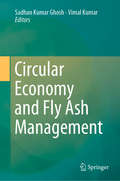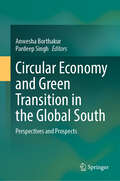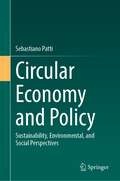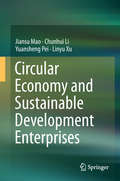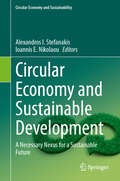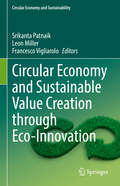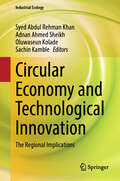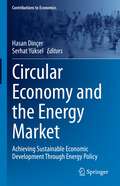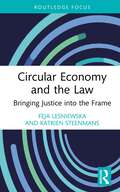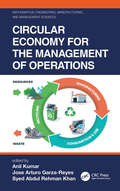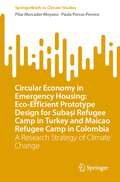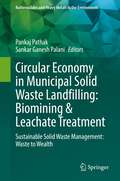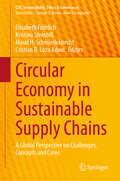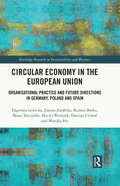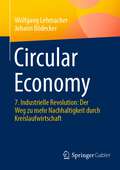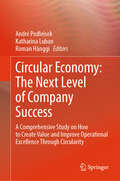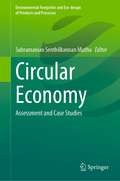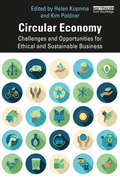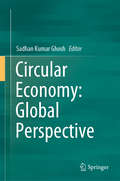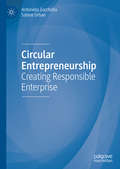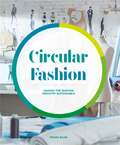- Table View
- List View
Circular Economy and Fly Ash Management
by Vimal Kumar Sadhan Kumar GhoshThis book presents a number of innovative uses of fly ash. Fly ash is a fine powder that is a byproduct of burning pulverized coal in thermal power plants. It is a pozzolan – a substance containing aluminous and siliceous material that when mixed with lime and water forms a compound similar to Portland cement. Though fly ash was a problem in terms of its disposal, it now has a variety of uses, such as a prime material in blocks, bricks, and PCC paving, and further applications are being investigated. As such, the recovery and reuse of fly ash wastes plays an important role in the implementation of the circular economy concept. Featuring selected, high-quality research papers presented at IconSWM 2018, the book provides valuable insights for the recycling industries, power plants, researchers, and governments.
Circular Economy and Green Transition in the Global South: Perspectives and Prospects
by Pardeep Singh Anwesha BorthakurThis book is an attempt to address circular economy and green transition potentials and implications with a particular focus on the Global South. Circular economy and green transition have been central themes of environmental policymaking during the recent decades—both in the Global North and the Global South. However, the focus and attention on the topics among the research community have been relatively recent in the emerging economies and developing countries in the Global South. The term, &“circular economy,&” refers to an economic model that aims to minimize waste, make the most of resources and promote sustainability throughout the entire lifecycle of products and materials. Unlike the traditional linear economy, which follows a &“take-make-dispose&” pattern, the circular economy seeks to create a closed-loop system where resources are reused and recycled. The term &“green transition,&” on the other hand, refers to a comprehensive and systemic shift from an economy that heavily relies on fossil fuels and environmentally destructive practices to one that is sustainable, eco-friendly and focused on addressing global climate change implications. Green transition is often considered as a critical approach to achieve a sustainable future and mitigate the adverse impacts of climate change. Circular economy and the green transition are complementary approaches that, when integrated, can lead to a robust sustainable global economy. Both concepts acknowledge the interconnectedness of environmental, economic and social facets and highlight the significance of a systematized change to achieve a better future. We can consider circular economy as a subset of green transition where both share the overarching goal of fostering sustainability and mitigating detrimental environmental impacts.
Circular Economy and Policy: Sustainability, Environmental, and Social Perspectives
by Sebastiano PattiThis book uses economic and policy approaches to highlight sustainability, environmental, and social aspects of the circular economy. It emphasizes the circular economy within the market’s perspective, including the links between consumption and sustainability, and how balances between profitability and environmental sustainability can be attained. The author also uses a life cycle assessment approach to improve and evaluate circular economy strategies to help determine the environmental, social, and economic consequences of a product. The chapters illustrate circular business models and sustainability consumption behaviour in the public sector, while also measuring eco-efficiency and sustainability impacts. The book will useful for students and researchers in environmental and sustainability economics, as well as businesses and government organizations adapting policies to develop environmentally sustainable economic practices.
Circular Economy and Sustainable Development Enterprises
by Jiansu Mao Chunhui Li Yuansheng Pei Linyu XuThis textbook systematically addresses why and how Circular Economy should be developed and practiced by employing a Discussion and Research (D&R) teaching method. This method allows us to show the whole process of academic research, from formulating the key questions, to methodology design, and ultimately to conclusions and applications. In addition, the suggested class discussions and group homework provide good opportunities for participant cooperation and exchange. In this textbook, all chapters and sections are intended to answer specific scientific key or sub-key questions, while all chapters are also internally structured logically and systematically, from question to final conclusion. This textbook may help to boost student performance in science and research and was selected for inclusion in the 13th Five-Year planning teaching materials for regular higher education in China.
Circular Economy and Sustainable Development: A Necessary Nexus for a Sustainable Future (Circular Economy and Sustainability)
by Alexandros I. Stefanakis Ioannis E. NikolaouThis book will highlight the role of CE in the sustainability field as it is expressed in the various fields and disciplines and its contribution to building a sustainable society by providing a better understanding of the relevant social and cultural structures and the need for cross-disciplinary knowledge and diverse skills. Such an integrated approach which combines the concept of sustainability in the engineering field to create a CE, has not yet been presented in detail in the published literature, and there are only scattered studies covering only small parts of this holistic approach. Hence, this book will represent a single reference that will provide summarized information and state-of-the-art knowledge on this topic of the future. The book will include chapters showcasing/investigating the relation between circular economy principles and their realization in different engineering fields. This includes theoretical justification, research studies and full-scale case studies. The approach focuses on two distinct levels: macro and micro, on both production and consumption sides.
Circular Economy and Sustainable Value Creation through Eco-Innovation (Circular Economy and Sustainability)
by Srikanta Patnaik Francesco Vigliarolo Leon MillerCircular economy and sustainable value creation through eco-innovation are interconnected concepts that revolve around creating a more sustainable and environmentally friendly approach to economic growth and business development. In a world confronted by pressing environmental challenges, the need for sustainable economic practices has never been more urgent. The traditional linear economic model, characterized by the "take-make-dispose" approach, has led to resource depletion, environmental degradation, and social inequalities. In response to these challenges, the concepts of circular economy and eco-innovation have emerged as powerful frameworks for reshaping our economic systems to prioritize sustainability. The circular economy represents a paradigm shift from the linear economic model that has dominated for centuries. Instead of viewing resources as finite and disposable, the circular economy embraces the idea that resources can be kept in circulation for as long as possible, thereby minimizing waste and environmental impact. At the core of the circular economy is the efficient use of resources. This entails reducing resource consumption, reusing products and materials, and recycling to extend the life of resources. Products are designed with durability and ease of repair in mind, ensuring they have a longer lifespan and can be easily maintained. Circular practices aim to restore natural systems and reduce harm to the environment, whether through reforestation, soil regeneration, or sustainable agriculture.
Circular Economy and Technological Innovation: The Regional Implications (Industrial Ecology)
by Syed Abdul Rehman Khan Oluwaseun Kolade Sachin Kamble Adnan Ahmed SheikhThis book explores the circular economy, its context, methodology, and commercial strategies, with a focus on waste minimization, recycling, green marketing, and sustainable business practices to facilitate resource recovery. It considers IR 4.0 and 5.0 to show how smart technology innovation extends circular economy through industrial organizational sustainability and investigates circular economy technology innovation in multiple scenarios to exploit product re-usability and technological innovation in Asian, European, and Australian contexts. It discusses novel digital technologies such as blockchain, additive manufacturing, AI, ML, and IoT for global supply chain tracking. This book is valuable for instructors and students in business, environmental studies, supply chain management, product re-manufacturing, and marketing programs seeking cutting-edge Circular Economy and Technological Innovation trends.
Circular Economy and its Implementations in Southeast Asia (Frontiers in South and Southeast Asian Development Research)
by Almas Heshmati Pham Khanh NamThis edited volume explores the implementation of the circular economy (CE) in Southeast Asia, a densely populated region with a significant share of global production. It examines the region’s transition from a linear to a circular economy, providing a comprehensive overview of CE applications across various parts of Southeast Asia. The book offers unique and empirical insights into the approaches, methods, laws, and policies that facilitate the transformation to a CE. It highlights how recent research, trends, and attitudes can be practically oriented towards sustainable development. By linking environmental theory with practice, the book provides practitioners with a deeper understanding of CE and the challenges involved in its implementation. A timely and practical guide, this book is essential for sustainability researchers and policymakers in Asia striving to achieve CE and sustainable development goals. It presents an up-to-date picture of Southeast Asia’s fast-growing economy, showcasing the region’s heavy investment in development infrastructure and cooperative efforts towards environmental sustainability. Authored by professionals with deep insights into the region’s economy and development potential, the chapters offer empirical, research-based perspectives on recent economic trends. This volume fills a crucial knowledge gap regarding Southeast Asian economies, their environmental conditions, and development potential. It also guides emerging economies like Vietnam in sustainable development, helping them avoid the pitfalls of environmental missteps in production, resource utilization, and consumption.
Circular Economy and the Energy Market: Achieving Sustainable Economic Development Through Energy Policy (Contributions to Economics)
by Hasan Dinçer Serhat YükselEnergy policies play a pivotal part in helping countries achieve their sustainable development goals. Further, energy is one of the critical raw materials in companies’ production processes. Therefore, ensuring a steady energy supply is essential to increasing production; otherwise, countries will inevitably slide into recession. In this context, countries should select their energy policies on the basis of a comprehensive analysis. In order to achieve this goal, many different factors must be considered at the same time.The aim of this book is to determine the right energy policies for the sustainable economic development of countries. In this framework, effective strategies for different types of energy will be presented and vital issues such as determining the right locations for nuclear power plants, providing optimal government incentives to increase clean energy investments, and determining appropriate energy policies to reduce energy dependence will be examined. Thus, country-specific optimal energy policies will be outlined, contributing to the achievement of the UN’s sustainable development goals (SDG).
Circular Economy and the Law: Bringing Justice into the Frame (Routledge Focus on Environment and Sustainability)
by Feja Lesniewska Katrien SteenmansThis book explores the role of law and policy in circular economy transitions and their impacts on justice, including on distributional equity and recognition and procedural rights, especially for people already marginalised under the current dominant economic system. Amid increasing demand for virgin raw materials, and unsustainable consumption and waste disposal that are driving the global ecological and climate crisis, there are growing calls to urgently transition to circular economies. Despite an increasing number of circular approaches being adopted, implemented, and integrated in national and local laws and policies, the number of commercially successful business stories remains isolated. Moreover, questions about whether circular economy laws and policies are delivering fair and just global outcomes need to be addressed. This book examines this significant knowledge gap to understand legal experiences, including justice and equity issues in the global context, so that these can inform wider design and implementation. The book begins by explaining the concept of a circular economy and its context within wider issues of sustainable development and justice. The first part of the book then examines the legal context of the circular economy by analysing legal forms in practice and those recommended in wider scholarship before considering how these could impact on existing inequity and injustices globally. The second part delivers an empirical understanding of the implications of the law on circular economy approaches and the global equity and justice dimensions through two case studies on solid waste management and forestry. The final part addresses legal opportunities and challenges for wider implementation of circular economy approaches that incorporate justice into its framing. This book will be of great interest to students, scholars, and practitioners of environmental and natural resource law and policy, circular economy, industrial ecology, natural resource management, and sustainable development more broadly.
Circular Economy for Renewable Energy (Green Energy and Technology)
by Viktor Koval Piotr OlczakThis book explores the role of renewable energy sources in driving sustainable development, with a focus on their circular use in achieving environmental efficiency and an energy balance. The authors highlights the significance of renewable energy in reducing costs for producers and consumers while also ensuring the production of clean energy that can be integrated seamlessly into the national power grid without compromising reliability or energy security.Readers are introduced to the circular economy model and its importance in the context of renewable energy. The book sheds light on the challenges associated with transitioning to alternative energy systems, particularly in cases where not all resources can be fully circulated. Through the research presented in this book, stakeholders will gain insights into how the sustainable renewable energy supply chain can be adapted within the circular economy. This will have a synergistic effect in reducing carbon emissions, and also aid in the production of renewable energy equipment.
Circular Economy for the Management of Operations (Mathematical Engineering, Manufacturing, and Management Sciences)
by Anil Kumar Syed Abdul Rehman Khan Jose Arturo Garza-ReyesCircular-Economy is a new concept in operations management. Its goal is to redefine growth, focusing on positive benefits arising for society as a whole out of efficiencies such as designing waste out the operations process. This book will help practitioners use the proper strategy for effective adoption of Circular practices to use in their organization. Features: Provides a complete understanding of Circular-Economy practices Offers advanced mathematical models to help industry management adopt the correct practices Presents a deep understanding of cross-functional and customer-focused design thinking Covers how to develop sustainable practices in all types of activities within operations management. Circular Economy for the Management of Operations will be of interest to practitioners and researchers in engineering as well as business management
Circular Economy in Emergency Housing: A Research Strategy of Climate Change (SpringerBriefs in Climate Studies)
by Pilar Mercader-Moyano Paula Porras-PereiraIn recent years, there has been an upsurge in the number of forced displacements due to natural disasters, armed conflicts, and pandemics, which has favoured an increase in the number of temporary accommodations. Although the provision of shelter after an emergency situation is one of the priorities of humanitarian aid, the reality is that the conditions in which people live in a situation of forced displacement are absolutely precarious and overcrowded. Nowadays, this type of housing tends to have a short lifespan, deepening the environmental impact and the generation of waste. Likewise, added to this great problem is the linear economic system implemented worldwide, which also causes a high rate of waste.This investigation develops an eco-efficient design protocol that determines the basic premises in any emergency situation, therefore avoiding the precarious nature to which those in forced displacement are exposed. Moreover, the research investigates different constructive solutions that can respond to situations of natural catastrophes or humanitarian disasters where emergency housing is needed as well as the possible alternatives from the point of view of circular economy. Eco-efficient and environmentally correct solutions are sought, which can be adaptable to the different scenarios where emergency housing may be needed, thus creating a rapid, easy, functional, and environmentally correct architecture, adaptable to these types of situations. The study shows that the factors that characterize emergency architecture can be an example of where the issues around the sustainability factor are applied in a practical way. The main objectives of this study are to develop an eco-efficient design protocol which determines the basic premises in any emergency situation and to find eco-efficient and environmentally correct solutions, adaptable to different scenarios, which have similar climatic characteristics, and where emergency housing may be needed, thus creating a type of ephemeral architecture but sensitive to the user to whom it is intended and in accordance with the optimal conditions of habitability.
Circular Economy in Municipal Solid Waste Landfilling: Sustainable Solid Waste Management: Waste to Wealth (Radionuclides and Heavy Metals in the Environment)
by Pankaj Pathak Sankar Ganesh PalaniThis book will serve as a ready reckoner of contemporary information regarding municipal solid waste landfill biomining, treatment of landfill leachate and heavy metals in a single platform. The academicians, researchers, and students at master’s and doctoral levels will be able to understand the current trends in municipal solid waste landfill operations, which will help in augmenting their research. Construction of new landfills requires huge monetary investments, which can be avoided if old landfills were bio-mined for resources and the space can be re-used as new landfills. Landfill leachate is a hazardous waste which needs proper treatment that could generate value-added products such as clean energy and biofertilizers. In this book, each chapter would provide the background, methodology, and relevant calculations for sustaining landfill operations. Also, the case studies based on best practices in municipal solid waste landfilling are discussed in this book.
Circular Economy in Sustainable Supply Chains: A Global Perspective on Challenges, Concepts and Cases (CSR, Sustainability, Ethics & Governance)
by Elisabeth Fröhlich Kristina Steinbiß Maud H. Schmiedeknecht Cristian R. Loza AdauiCircularity is one of the most promising innovative business models for tackling the challenges posed by climate protection, resource conservation and biodiversity conservation. Circularity requires changed business structures; therefore, it is necessary to adapt existing approaches and reconcile economic and ecological interests. By focusing on the importance of horizontal integration and cross-company cooperation, this book offers valuable insights to help companies generate cross-industry synergy and symbiosis effects and secure competitive advantages along sustainable supply chains. The emphasis is on an expanded understanding of the various R principles, and on theoretical and practical application examples that help to prepare corporate business models for the ecological and social challenges of global supply chains. Given its scope, the book represents an indispensable guide for companies worldwide that want to contribute to sustainable development by adopting circular business models. It analyses the drivers and challenges of implementing these models and presents concepts and insights from pioneering companies in the circular economy, providing a global perspective for managers and researchers alike.
Circular Economy in the European Union: Organisational Practice and Future Directions in Germany, Poland and Spain (Routledge Research in Sustainability and Business)
by Dagmara Lewicka Joanna Zarębska Roman Batko Beata Tarczydło Maciej Wożniak Dariusz Cichoń Monika PecCircular Economy in the European Union: Organisational Practice and Future Directions in Germany, Poland and Spain presents the EU's journey towards a Circular Economy (CE), identifying significant organizational practices in this gradually adopted field among member countries. The book also aims to develop and propose innovative initiatives and practices for implementing CE across various economic sectors in selected EU countries, such as Poland, Spain and Germany. Covering topics which include the implementation of CE in the EU and worldwide, green employee behaviors, corporate social responsibility in creating pro-environmental attitudes and models of eco-digital factory transformation in SMEs, the book emphasizes the importance of innovative, environmentally friendly, low-waste, and low-emission technologies. Consisting of thirteen interconnected chapters, it discusses the challenges and opportunities of CE, the importance of business engagement in addressing social and environmental problems, and provides practical examples of innovative solutions in various sectors. This volume will be of great interest to students and scholars of circular economy, corporate governance, business ethics and sustainable business, as well as entrepreneurs, managers, government representatives, and non-governmental organizations active in CE.
Circular Economy: 7. Industrielle Revolution: Der Weg zu mehr Nachhaltigkeit durch Kreislaufwirtschaft
by Wolfgang Lehmacher Johann BödeckerWenn wir unseren Lebensstandard und Lebensraum erhalten wollen, müssen wir radikal umdenken und unsere Wirtschaft neu gestalten. Gefragt ist eine zirkuläre, umwelt-zentrierte Wirtschaft. Nur wenn es gelingt, bei unserem Handeln auf den Gesamtkomplex Leben Rücksicht zu nehmen, werden wir unseren Planeten erhalten können – und damit unseren Wohlstand und unsere Lebensqualität langfristig sichern.Das Buch beschreibt sehr anschaulich, was Circular Economy für Unternehmen und die gesamte Wirtschaft bedeutet. Zahlreiche Beispiele und strategische Umsetzungsideen bieten einen Einblick in die erfolgreiche Realisierung.
Circular Economy: A Comprehensive Study on How to Create Value and Improve Operational Excellence Through Circularity
by Roman Hänggi Katharina Luban André PodleisekWithout any doubt, the current prevailing Linear Economy principle of take-make-dispose is inherently unsustainable: Raw materials are extracted, transformed into products, and discarded as waste after use. The resulting environmental and economic challenges brought together both practitioners and academics to develop more sustainable methods for production and consumption. Especially the concept of Circular Economy has received a lot of attention. But despite many technical solutions, a key question for practical implementation has remained unanswered until now: How can enterprises integrate Circular Economy into their business strategy to leverage success? This book examines the topic of Circular Economy in an entrepreneurial context. It describes ten options for companies to retain value and identifies drivers and enablers for implementing Circular Economy in businesses. A survey among more than 500 industry experts revealed the extent to which retention options were implemented in practice. For the first time, relevant drivers and enablers for each retention option were identified. On top of this, case studies of successful circular market offerings shed light on each retention option in detail. The knowledge gained from research and the further shared experiences of experts that contributed to this book result in a 6-step management model. This model provides guidance on how to implement Circular Economy in organisations as an element of operational excellence and as a source of product, service, and business innovation. Now, every enterprise can start the journey. As the survey and the cases show: Circular Economy is a promising way to the next level of company success. The book at hand will help organisations to develop their own individual approach that matches their business model. In short, you will find: First comprehensive analysis of 10 retention options, their drivers, and enablers. Survey of more than 500 companies and in-depth case studies for each retention option. Practical research-based implementation model for companies.
Circular Economy: Assessment and Case Studies (Environmental Footprints and Eco-design of Products and Processes)
by Subramanian Senthilkannan MuthuThis book highlights the notion of Circular Economy under the umbrella of Sustainability because of the widespread momentum it is gaining. Today the whole world is certainly in emergent need of an alternative system to traditional economy which is linear, i.e. make, use and dispose to get rid-off the waste and very important to ensure continuous use of resources, which is possible by the advent of circular economy. A circular economy aims to utilize the resources in use for as long as possible, extract the maximum value from them during use, then recover and regenerate products and materials at the end of each service life vis-à-vis traditional linear model. This book discusses circular economy in terms of assessment with various case studies.
Circular Economy: Challenges and Opportunities for Ethical and Sustainable Business
by Helen Kopnina; Kim PoldnerHow can we design circular business models? How can we organize the transition from a linear to a circular economy? And how can we imagine circular futures that help us transform current realities? This book aims to provide answers to these questions while addressing the challenges and opportunities of the circular economy. The authors reflect on why conventional sustainability models – such as the ‘triple P’ (People, Profit and Planet) or eco-efficiency – have failed in addressing environmental challenges, including climate change, biodiversity loss and pollution. They then move on to explore innovative circular business models, which propose to eliminate environmental damage by radically reforming the system of industrial production. Organizing the transition is a collaborative effort: entrepreneurs, consumers, policymakers, multinationals and intermediaries need to work together to foster the emergence of the circular economy as an institutional field. Together with younger generations of learners and equipped with beyond-human-centred values towards awareness of the material and natural world, novel circular futures can be imagined. Offering points of reference for continued critical discourse and examples of practically applicable sustainability solutions, this book will be of great interest to students, teachers, practitioners and scholars of circular economy.
Circular Economy: Global Perspective
by Sadhan Kumar GhoshA circular economy is an alternative to a traditional linear economy (make, use, dispose) in which we keep resources in use for as long as possible, extract the maximum value from them whilst in use, then recover and regenerate products and materials at the end of each service life. Circular economy (CE) is important towards sustainable development, resources circulation and conservation, involving closing of material loops and cascading used resources, to prevent waste occurrence, and transforming the resulting residual streams into new (secondary) resources. Strategies and legislative framework for waste management are important steps for development of a more CE where resource efficiency becomes the key driver for both economic growth and environmental protections. A few countries achieved good results implementing CE as a replacement of the linear economy. Resource managers and planners should thoroughly identify factors to implement CE for societal benefits. This book presents how resource consumption is minimized with rational use based on 3Rs, legislative framework and government supports towards implementing CE initiatives, example of best practices, future plans and targets in different countries those are helpful for researchers, planners and implementers.
Circular Economy: Impact on Carbon and Water Footprint (Environmental Footprints and Eco-design of Products and Processes)
by Subramanian Senthilkannan Muthu Aldo Alvarez-Risco Shyla Del-Aguila-ArcentalesThis book highlights ways to evaluate circular economy using global standard and footprints the way global firms are using to ensure the measurement of the impact. It presents various case studies from different sectors with the efforts made to contribute to circular economy and at the same time its contribution to minimize carbon and water footprints.
Circular Entrepreneurship: Creating Responsible Enterprise
by Antonella Zucchella Sabine UrbanThis original book explores how the principles of circularity, considered a law of nature but neglected within the materialistic orientation of the industrial age, are becoming attractive again in business and society. Investigation reveals enterprises small and large delivering a stimulating message, from changes in entrepreneurial mindsets to the inclusive use of new technologies and a push for innovation. Zucchella and Urban explore the novel concept of circular enterprise, showing how, with their capacity to innovate, these firms are becoming the most powerful actors of a new, sustainable social order. They examine two fundamental questions: why is this revolution occurring now, and how is it being implemented? Focusing on the most innovative practices, they demonstrate the potential of circular enterprise for industry and wider society, making clear that a new world is emerging.
Circular Fashion: Making the Fashion Industry Sustainable
by Peggy BlumCreating sustainable fashion has never been more important. Circular Fashion provides an accessible, practical, and holistic approach to this key topic for anyone studying fashion.This introductory text to sustainability in fashion includes best practice case studies and profiles of key companies such as Patagonia, Veja, Christopher Raeburn, and Stella McCartney. It begins with an overview of the fashion business, tackling the issues of the linear production model of make, use, dispose, before introducing the idea of the circular supply chain.Circular Fashion is the must-have book for fashion students, creatives and anyone passionate about sustainability and fashion.
Circular Fashion: Making the Fashion Industry Sustainable
by Peggy BlumCreating sustainable fashion has never been more important. Circular Fashion provides an accessible, practical, and holistic approach to this key topic for anyone studying fashion.This introductory text to sustainability in fashion includes best practice case studies and profiles of key companies such as Patagonia, Veja, Christopher Raeburn, and Stella McCartney. It begins with an overview of the fashion business, tackling the issues of the linear production model of make, use, dispose, before introducing the idea of the circular supply chain.Circular Fashion is the must-have book for fashion students, creatives and anyone passionate about sustainability and fashion.
